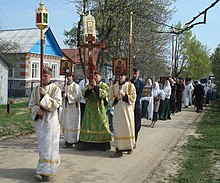Cross procession


The cross procession ( Russian Крестный ход , transcribed Krestny Chod ) is a procession in the Orthodox churches , including the Russian Orthodox Church , which is mainly held on certain ecclesiastical holidays.
description
As a rule, one moves with the cross either around a church building or from one church to another. The occasion of a cross procession in the Russian Orthodox Church is usually Easter or the feast of the Epiphany . But there are also cross processions on special occasions, such as the consecration of a new church, extraordinary state celebrations or natural disasters. At Easter in Russia a cross procession is held around every Orthodox church, which is then led by the respective head of the community.
If the procession is a circular procession, in the Russian Orthodox Church it is always carried out counterclockwise, i.e. against the movement of the sun , whereas the circular processions of the ancient Orthodox Christians run clockwise. The procession often goes around the church three times. A lantern is always carried at the very front of a cross procession, the cross only comes in the second row, followed by icons , Orthodox banners and relics . The procession is accompanied by the church choir , which sings the hymns .
Well-known cross processions
During the times of the Russian Empire , the Red Square in Moscow, where St. Basil's Cathedral is located, was always the site of the most important cross processions. These took place not only on the Orthodox festivals, but also every year on the anniversary of the liberation of Russia from the Polish-Lithuanian interventions (today this day, which is celebrated on November 4th, is known as the Day of People's Unity ). The procession led by both the Patriarch of the Russian Orthodox Church and the Tsar moved from St. Basil's Cathedral to the Kazan Cathedral .
There have also been particularly long cross processions in history:
- From July 28 to August 1, 1991 there was an extraordinary procession of the cross from Moscow to the Seraphim Monastery of Diwejewo in the Nizhny Novgorod Oblast . The reason for this was the retrieval of the relics of St. Seraphim of Sarov , a starzen who lived near the monastery.
- The longest cross procession in history took place on May 20, 2007 in Vladivostok from the Russian Pacific coast to Moscow. At the same time, a number of other processions were carried out from other Russian cities, all of which ended in Moscow in June 2008. The reason for this was the union of the Moscow Russian Orthodox Church with the Russian Orthodox Church abroad , which was sealed in 2007, and the celebrations for the 125th anniversary of the Moscow Cathedral of Christ the Savior in June 2008.
See also
Individual evidence
- ↑ http://vladivostok.eparhia.ru/news/eparchy/?ID=1100
- ↑ Archived copy ( memento of the original dated June 11, 2008 in the Internet Archive ) Info: The archive link was inserted automatically and has not yet been checked. Please check the original and archive link according to the instructions and then remove this notice.
- ↑ Archived copy ( Memento of the original dated June 12, 2008 in the Internet Archive ) Info: The archive link was inserted automatically and has not yet been checked. Please check the original and archive link according to the instructions and then remove this notice.